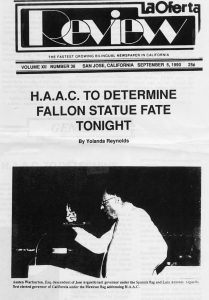September 5, 1990
By Yolanda Reynolds

Last week the Historic’ Arts advisory Committee meeting brought together a number of historians from throughout the Bay Area whose specialty is early day California history.
Most of the historians who spoke before the committee at that meeting felt that Fallon’s raising of the American flag was not really historically significant.
In fact one military historian, retired Major Theodore Baltes, says that the illustrations of the proposed statue show the flag half-mast – hardly the position for the American flag in a “flag raising.”
Further, Major Baltes, a member of a select organization of retired military historians, says that a “flag raising” involves raising the flag with ceremony on a standard or a mast (if at sea) with officers at attention and a bugle being played.
More severely criticized was the lack of scholarship in the book “California Cavalier: Captain Thomas Fallon” written by Thomas McEnery before he came Mayor of San Jose. When he wrote this book he was member of the San Jose City Council.
His account of Thomas Fallon’s involvement in the Donner rescue is challenged; as is his account of the raising of the flag as a heroic act. According to historian Joseph King, Fallon waited until the Mexicans were out of town before he came forward with the flag.
Questions were raised about Fallon’s conduct as a husband, father, son-in-law, citizen, mayor, churchman and military service.
Evidently the author of the book, “California Cavalier,” anticipated some question. The final paragraph of the book states “All the major events both local and national actually happened just this way. The people were all very, very real. Thomas Fallon spoke and wrote just as the Journal has recorded it. Perhaps there might be a question as to whether the lost leather bound Journal actually fell from its hiding compartment early in the summer of 1978. This is quite normal and to those skeptics, I can only say if it did not, it certainly should have.”
The author in this disclaimer only admits that the Journal may not have been hidden as claimed – but the implication is that a Journal does in fact exist. To this date no one, except possibly the author, is reputed to have laid eyes on this Journal.
The book was copyrighted in 1978; the date of publication is not known for certain. According to historians, when the book was first reviewed by knowledgeable historians; members of the California Historical Society raised quite a fuss. The issues of the California Historical Society monthly newsletters that contained this controversy are missing from the files of the Main Martin Luther King Library in downtown San Jose.
According to Alex Stuart. Esq., chairman of HAAC, the next meeting of the Committee will be to address two items: 1.) Old Business – Thomas Fallon Statue: Decision and 2.) New business – Committee Procedures – Guidelines for addressing the second part of the committee’s charge which is to develop a prioritized list of events and personages for commemorative art in the city.
According to remarks made when the committee first convened, the committee has four options regarding the fate of the Fallon statue; 1.) No Fallon statue in San Jose; 2.) Place Fallon statue as originally proposed, on the north island of Plaza Park; 3.) Place Fallon statue somewhere else in San Jose; 4.) Store Fallon until the prioritized list of events and personages are decided upon for commemoration in the city and decide then whether to erect the statue or not.
Option 1. is favored by many historians, most Hispanics and many others because of Fallon’s lack of historical significance, poor personal reputation and because Fallon is portrayed as a conqueror and reminds many of the controversial war that is known as the Mexican-American War that resulted in California and three other U.S. states being carved out of land that had been part of Mexico.
Option 2 is sought by Mayor McEnery and his supporters some of whom call themselves. “Los Amigos de Fallon,” of whom one representative, Maureen Lennon, addressed the committee that night.
Option 3 has been proposed by several people including Blanca Alvarado. Some have suggested the Historical Museum at Kelly Park.
Some that it be placed at the soon to be restored Fallon House on St. John Street. For some this suggestion carries some interesting conditions – that the name Fallon be removed from the base of the statue and that the stat be characterized only as a pair of “settlers” in California in the mid 1850’s.
Finally regarding Option 4 a considerable number of people feel it is wise to wait until the criteria for the selection of Historic arts is developed before a decision is be made by the committee regarding the ultimate fate of the Thomas Fallon statue.
Many who have followed the controversy closely feel that to make
a hasty decision would be to continue the controversy. The Committee has in its power the ability to demonstrate to all that the democratic process in decision making is not only the best method in arriving at solutions or decisions but can provide a unifying learning experience as well.
HAAC Chairman Stuart! And Yankee Johnson, Fine Arts Director for the City believe that the committee will meet the mayor’s request for a decision on the Fallout statue by September 5.
The next HAAC meeting is September 5, 7 pm. in the City Council Chambers at City Hall.
